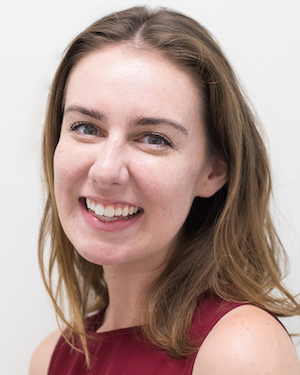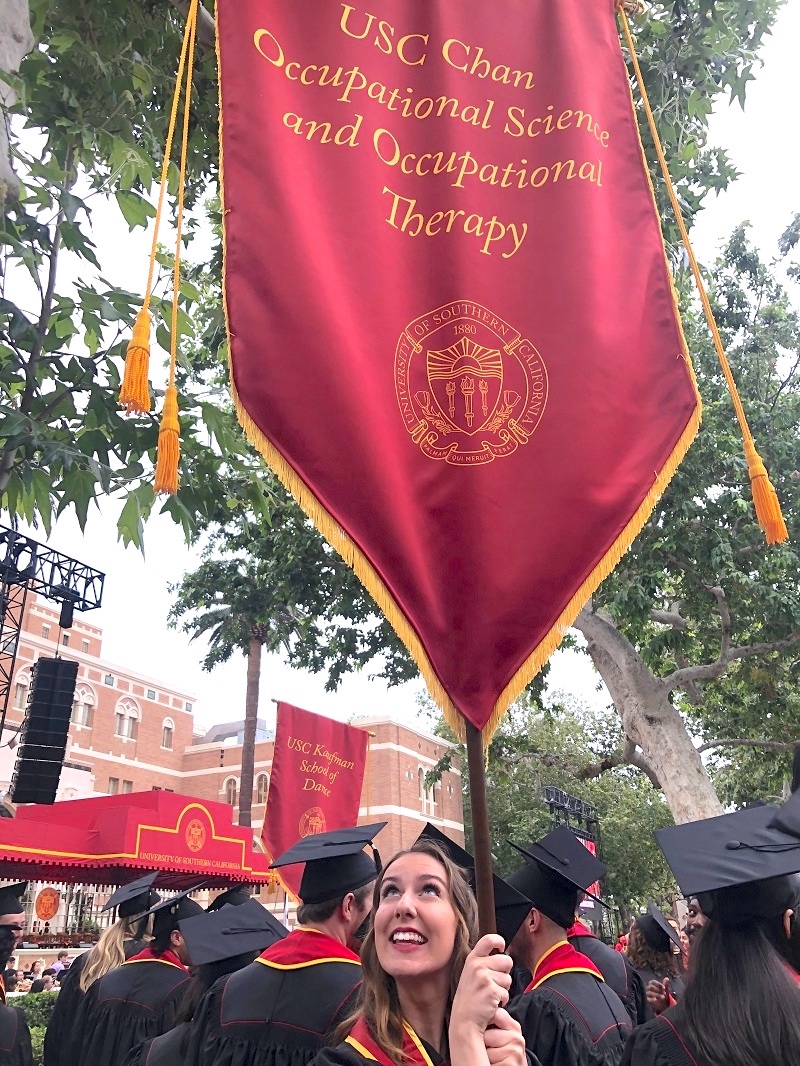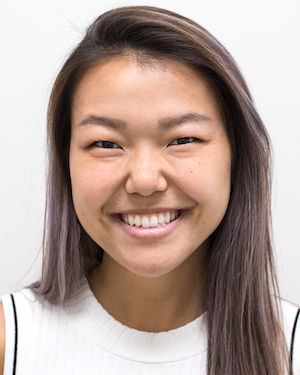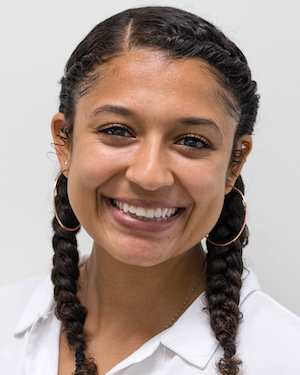Student Blog

What a Difference a Year Makes! ⟩
September 3, 2019, by Noelle
I introduced myself to someone at the main campus the other day and when they asked me what year I was in I was super excited to say “I’m a second year grad student!” I think I shocked him with my enthusiasm, but what he didn’t know was that my answer to that question used to be . . . complicated. Last year, I was straddling the identities of undergraduate senior and 1st year Master’s student; I was a grad student that hadn’t actually graduated yet. Entering my 5th year of the Bachelor’s to Master’s OT program, I have become very accustomed to explaining every aspect of my student identity — answering the questions: “What is Occupational Therapy? When do you graduate? Wait, so how old are you?” And now that I have officially graduated from undergrad, my spiel is much less confusing. More importantly, I’ve noticed a change in my attitude and feelings about my student identity.
The transition to graduate school is major for anyone whether it happens before, immediately following, or several years after completing undergrad. And last year, I felt it acutely. I missed all of the elective courses I used to take, not starting class until 11 am on some days, the freedom to take naps during the week!!! It’s not that I didn’t love the course material we were learning or the people in the program, it was just at times I wished I had one more year of all of that like the rest of my undergrad friends. But as my mom always says, nothing lasts forever!
I’ll be honest and say that I was very anxious to start this year. I have the responsibilities of this position as an ambassador and the demands of all of my courses, not to mention the huge decisions regarding the OTD coming my way (I’ll leave that for another entry though!). Although I’ve been studying OT for 4 years now, I’m still unsure where exactly I want my path to lead. Despite this uncertainty about my future (which is quite recent by the way), I came home from the first day of class this semester with unexpected peace of mind. I have my bachelor’s degree and a level 2 fieldwork under my belt, and I am just as thrilled to be an OT student as I was my freshman year. This year is sure to bring more changes and surprises that will influence this path I’m always talking about, and I just have to keep reminding myself how wonderful it is to be where I am and that the best is yet to come.
P.S. I originally wanted to title my entries with song titles (yes, like Grey’s Anatomy), but that was going to be harder than I imagined. So instead I’m going to include a song recommendation that may or may not relate to the entry 😊 This week’s pick happens to: “Ooh Child” by The Five Stair Steps.

Me holding the banner at Commencement 2019
⋯

Why Occupational Therapy? ⟩
September 3, 2019, by Kevin
Why did I choose occupational therapy? This is a question that I have been asked countless times during my time at USC. While I usually have a quick one-line statement to summarize my decision to pursue this career, here is the full story:
After graduating from San Diego State, I moved up to Los Angeles and began looking for jobs. Quickly, I found a position working at a company that provides behavioral therapy to children with a variety of diagnoses. While I found that work rewarding and I loved the population, there was something missing from the experience that I couldn’t quite put a finger on. Then one day at work, I shadowed my client’s occupational therapist and had a lightbulb moment that this was what I had been missing. The way the client responded to the therapy and the nature of using occupation as a means of therapy was the piece of the puzzle that I was searching for in a career. To be able to build authentic relationships with people while assisting their development was my idea of a perfect profession. Since attending USC, I have experienced the joy of aiding others to participate in the activities that bring meaning to their life. Each day I feel lucky to have discovered this gem of a profession and to be surrounded by instructors and peers who truly share the same passion and drive for occupational therapy.
⋯

Why Occupational Therapy? ⟩
August 29, 2019, by Kaho
I’ve always thought that I would pursue a career in the health field, but I thought that I was meant to become a doctor. It wasn’t until my sophomore year of college that I started to question whether I was pursuing a career as a doctor because I was actually passionate about it, or because I had never learned much about the other existing health professions. As I started to explore and research more options, I fell upon occupational therapy.
The first thing that pulled me towards it is the deep, personal relationship that OTs build with their clients. They get to know their clients as a unique human being in various contexts and they are dedicated to helping people engage in activities/roles that are meaningful to them. I love that occupational therapy integrates mental health with physical health because I am passionate about both. The more I learned about the profession, the more I fell in love with it and the more I felt like this was truly what I was meant to be. (Also worthy to mention that occupational therapy is ranked #13 by U.S. News as one of the best jobs of 2019!) I began the process of looking up potential schools and the prerequisites for applying to those schools. I began volunteering in various hospitals in order to see real OTs in action. For example, I observed a hand therapist during my junior year of college and over the summers when I would fly home to Japan for several months, I volunteered in the geriatric department at several hospitals. I still had trouble explaining to people what exactly occupational therapy is and I now know that my knowledge of the profession at that time was still very limited, but I was confident that I had found my dream job.
Occupational therapy is truly an incredible and beautiful profession and this past year in the program has expanded my interests on what population I want to serve in what setting. I am very fortunate to be studying occupational therapy at one of the leading universities of the profession and I am thrilled to continue learning and growing and see what all is in store for my last year in the program!
⋯

Plan. Period! ⟩
August 29, 2019, by Kat
The new semester is starting and I already have tons of things on my to-do list. Whats my game plan for the semester? A PLANNER!! During the fall semester I will be in the Adult Rehab immersion, working as a student ambassador for the Chan Division, and trying to balance life with family and friends. Personally, I find that a planner saves my life during a busy season. Writing due dates for assignments, work schedule, and dates with friends helps me keep track of upcoming events and how to prioritize my week. Having a visual aid for me to help support my completion of tasks and responsibilities is something that could also be done with a client to support their engagement in meaningful occupations.
Kickboxing, running, cooking, and hanging out with friends are some of my favorite occupations. With a busy semester ahead, it is important for me to make time for my meaningful occupations in order to stay sane and find a little time for self-care. Finding activities that help you rejuvenate, clear your mind, and that you enjoy are an important part of living a balanced life. I am able to find time for my favorite occupations by planning ahead and using time management skills. By practicing these skills on myself, I am able to refine them so I can implement or adjust them with future clients.
There are many ways to stay organized, such as using Google Calendar, reminders on your phone, sticky notes on your mirror, or old school paper and pen. All in all, be an OT and get creative. Find the method that works best for you! It may also work for a future client!
⋯

Why I Chose the OTD ⟩
August 29, 2019, by Catherine
For me, returning to school to pursue a second Master’s degree felt like running into a deep and dark tunnel. Despite this, the first time I stepped foot into CHP for an informational session of the program, I had a sense that I was becoming a part of something great. The amazing faculty, robust programs, and sense of community among others, has always made me proud to be a Trojan. I must admit that there were times I would get overwhelmed and second guess whether I would be able to power through to graduation. Then Fall Semester of my second year came. I was hesitant. The idea of staying on for the OTD had always been at the back of my mind from day one. However, I found myself questioning if even know where I wanted to be for my residency. I still had one immersion left. What I needed at that time was to “OT myself”. After taking a step back and allowing myself to breathe, I made a list of the pros and cons of applying for the OTD. I reflected on my initial inspiration of why I wanted to be an OT. Having this visual, and having taken the time to re-connect with my goals, I was able to see that all the amazing qualities of Chan that inspired me to apply for the Masters, stood true of the Doctorate. However this time, I wasn’t running into darkness unarmed. With me were all the tools of an entry-level practitioner. Now that I am beginning my residency, I strongly feel that I made the right choice. I find myself better positioned to expand my knowledge to elevate my future practice with the support of my mentor, Dr. Rebecca Aldrich, and the Chan Division. Moving forward, I am excited to share with you my experience and hope to provide useful insights into OTD.
⋯





